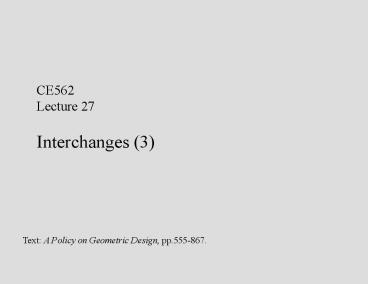CE562 Lecture 27 Interchanges 3 - PowerPoint PPT Presentation
1 / 30
Title:
CE562 Lecture 27 Interchanges 3
Description:
Undesirable. collision. point. Ineffective use. of the ramp or. undesirable. collision point. Lane Balance. Direction of traffic. Lane Balance. Any problems? ... – PowerPoint PPT presentation
Number of Views:183
Avg rating:3.0/5.0
Title: CE562 Lecture 27 Interchanges 3
1
CE562 Lecture 27Interchanges (3)
Text A Policy on Geometric Design, pp.555-867.
2
Selecting Interchange Type in Rural Areas
- System interchanges (freeway - freeway)
- Traffic volumes Type of interchange
- Strong turning volumes All-directional
- Some turning volumes are strong Semi-directional
- Weak left turns Full cloverleaf
- Moderate left turns Cloverleaf with
collector- distributor roads. - Service interchanges (freeway - non-freeway)
- Diamond interchange
- Partial cloverleaf (right-of-way restricted)
3
Selecting Interchange Type in Urban Areas
- System interchanges versus service interchanges
- Interchanges in urban areas are closely spaced
- System-wide design instead of individual
interchanges - Cloverleaf interchanges are not used
4
Design Considerations
- Capacity
- Route continuity
- Uniformity of exit patterns
- Single exits in advance of the structure
- Weaving sections
- Potential for signing
- Costs
- Availability of right-of-way
- Potential for stage construction
- Compatibility with the environment
5
Adaptability of Interchanges
6
Alignment, Profile, and Cross Section
- Design standard in the interchange area should be
the same as on the approach section - Controls for horizontal and vertical alignments
according to the general rules - Widening and dividing of non-freeways is
sometimes required to channelize the at-grade
intersections with ramps
7
Alignment, Profile, and Cross Section
8
Sight Distance
- Design of the vertical alignment is the same as
for the other points on the highway - The horizontal sight distance in the presence of
piers and abutments emphasizes the need for
above-minimum design of curves. Sometimes the
lateral clearances should be increased.
9
Interchange Spacing
- Minimum spacing of interchanges depends on the
weaving volumes, ability to sign, and required
length of speed-change lanes. - A rule of thumb min. 1.5 km in urban areas,
min.3.0 km in rural areas.
10
Route Continuity
11
Route Continuity
12
Basic Number of Lanes
- The basic number of lanes should be maintained
over a long length of the freeway. - The number of lanes is predicated on the design
hourly volume (DHV) and required level of
service.
13
Basic Number of Lanes
14
Lane Balance
Direction of traffic
Two-lane off- and on-ramps are needed
15
Lane Balance
Direction of traffic
Ineffective use of the ramp
Visibility obstructed
Any problems?
16
Lane Balance
Direction of traffic
17
Lane Balance
Direction of traffic
18
Lane Balance
Direction of traffic
Only three lanes
Any problems?
19
Lane Balance
Direction of traffic
Any problems?
20
Lane Balance
Direction of traffic
A?BR-1
BAR-1
Any problems?
NO PROBLEMS !
21
Dropping Auxiliary Lanes
22
Dropping Auxiliary Lanes
23
Dropping Auxiliary Lanes
24
Dropping Auxiliary Lanes
25
Adding Auxiliary Lanes
26
Basic Lanes Reduction
- Lane reduction is allowed
- at interchanges
- between interchanges
- Lane drop design
- If between interchanges, then at least 600-900 m
from the last ramp intersection (proper signing) - On right-hand side
- On horizontal tangents
- Before crest curves or on sag curves
- Minimum taper is 501
- Desirable taper is 701
27
Collector-Distributor Roads
- Used to remove weaving from the through lanes
- One or two lanes
- Design speed between 60 and 80 km/h
- Equal to or 10 km/h less than the speed on the
main roadway - Separation from the main roadway must accommodate
shoulders and barriers.
28
Types of Ramps
29
Types of Ramps
30
Design Speeds for Ramps
See Exhibit 3-43
Exhibit 10-56
Semidirect and direct connectors
Loops
Ramps for right turns































